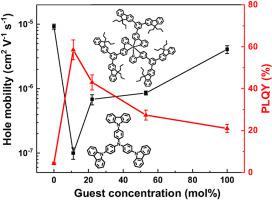Organic Electronics ( IF 3.2 ) Pub Date : 2021-08-28 , DOI: 10.1016/j.orgel.2021.106321 Mile Gao 1 , Junhyuk Jang 1 , Van T.N. Mai 1 , Chandana Sampath Kumara Ranasinghe 1 , Ronan Chu 1 , Paul L. Burn 1 , Ian R. Gentle 1 , Almantas Pivrikas 2 , Paul E. Shaw 1

|
Fac-tris[2-phenylpyridinato-C2,N]iridium(III) [Ir(ppy)3] is a well-known phosphorescent material for organic light-emitting diodes (OLEDs) and while uniform thin films can be formed using evaporation under high vacuum, it is not sufficiently soluble to enable it to be processed from solution. Ir(ppy)3-cored dendrimers with solubilizing surface groups can be processed from solution to form good quality neat or guest:host blends, even when the host has relatively poor solubility. In this manuscript, we report the effect of adding different solubilizing surface groups, namely 2-ethylhexyloxy, n-propyl or t-butyl to first generation dendrons attached to the Ir(ppy)3 core on the optoelectronic properties of neat and blend films with tris(4-carbazoyl-9-ylphenyl)amine (TCTA). The different dendrons were found to have minimal effect on the photoluminescence spectra and efficiency of energy transfer from the host to the guest in the blend films. The hole mobility of neat films of the solution-processed Ir(ppy)3-cored dendrimer films was around 10−6 cm2 V−1 s−1, which was an order of magnitude less than Ir(ppy)3 films formed by evaporation. Blending the dendrimers with TCTA at a concentration of 11 mol% (the concentration of the highest film photoluminescence quantum yield) led to an order of magnitude decrease in the hole mobility compared to the neat films. However, despite the relatively low mobilities, simple two-layer OLEDs composed of a blend light-emitting layer and an electron transporting layer were found to reach a maximum EQE of 11.1% at a luminance of 1000 cd m−2 for a film with a PLQY of 60%.
中文翻译:

树枝状聚合物表面基团对磷光发光膜性能的影响
Fac -tris[2-phenylpyridinato- C 2 , N ]iridium(III) [Ir(ppy) 3 ] 是众所周知的有机发光二极管 (OLED) 磷光材料,同时可以使用蒸发形成均匀的薄膜在高真空下,它的溶解度不足以使其从溶液中加工出来。具有增溶表面基团的Ir(ppy) 3核树枝状大分子可以从溶液中加工形成高质量的纯净物或客体:主体混合物,即使主体溶解度相对较差。在这份手稿中,我们报告了添加不同增溶表面基团的效果,即 2-乙基己氧基、正丙基或t丁基到第一代树枝状分子附着在 Ir(ppy) 3核上,关于纯薄膜和三(4-咔唑基-9-基苯基)胺 (TCTA) 混合薄膜的光电特性。发现不同的树枝对共混膜中光致发光光谱和从主体到客体的能量转移效率的影响最小。溶液处理的 Ir(ppy) 3核树枝状聚合物薄膜的纯薄膜的空穴迁移率约为 10 -6 cm 2 V -1 s -1,这比 Ir(ppy) 3小一个数量级蒸发形成的薄膜。与纯薄膜相比,将树枝状聚合物与 TCTA 以 11 mol% 的浓度(最高薄膜光致发光量子产率的浓度)混合导致空穴迁移率下降一个数量级。然而,尽管相对低的迁移率,混合发光层和电子传输层组成的简单的两层的OLED被发现在1000 CD m 2的亮度,以达到11.1%的最大EQE -2用于与薄膜PLQY 为 60%。


























 京公网安备 11010802027423号
京公网安备 11010802027423号